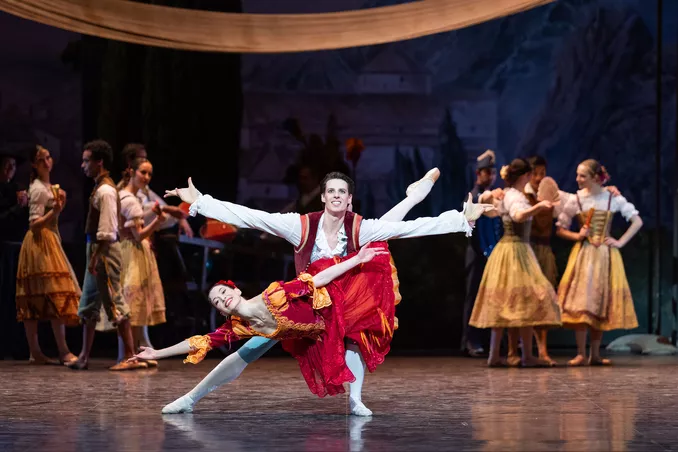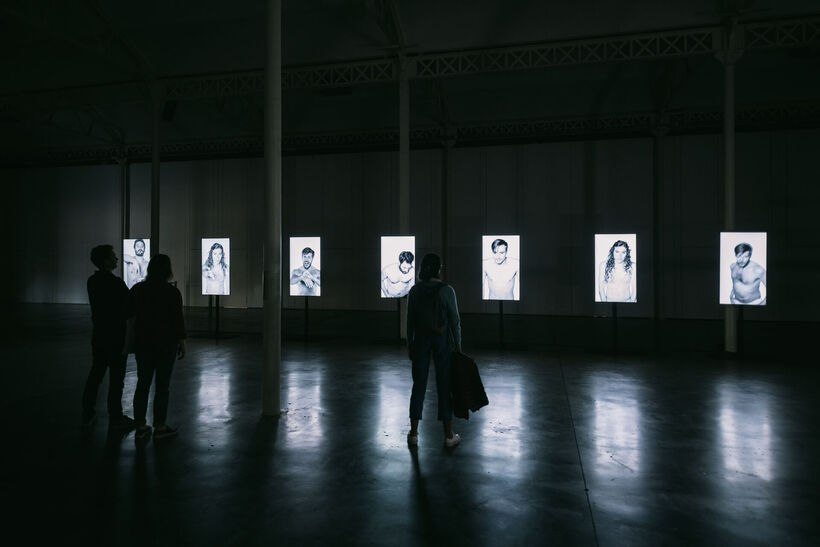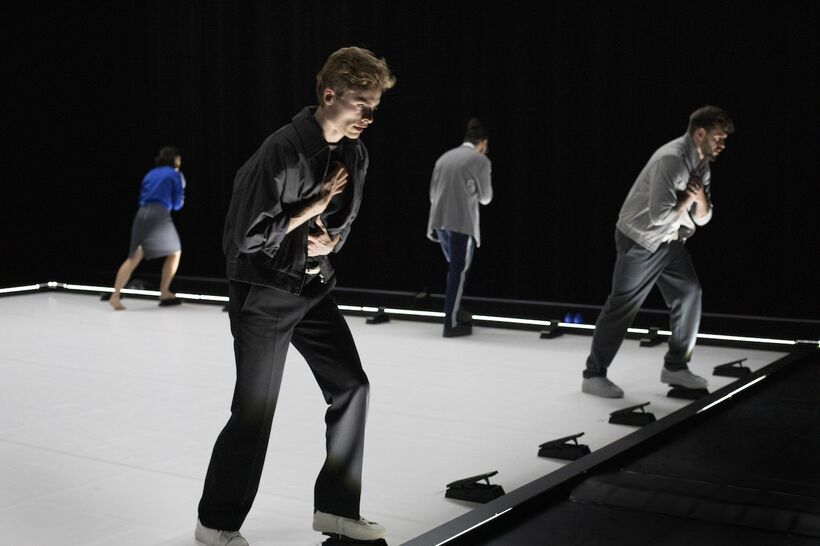Yet this high demand hasn’t stopped the government from announcing severe budget cuts to multiple sectors, including the arts, that will have a major impact on the forthcoming season. Citing national debt and the war in Ukraine, France’s austerity measures will result in an estimated 54% fewer performances in 2024-2025 (see France Info). Concretely, the French Ministry of Culture is confronting a loss of 200 million euros, half of which had been reserved for new productions. It’s hard to imagine anything but bleak results, particularly when theatres have already begun navigating inflation costs by maintaining a safe (albeit varied) program this spring.
Stories that shape us
Under José Martinez’s direction, classics are back at the Paris Opera Ballet. All of them are revivals, most of which reflect the company’s longstanding affiliation with Rudolf Nureyev, who directed the troupe from 1983-1989. Nureyev’s heritage at the POB is lauded by some and a prickly topic for others, who would prefer to see a more varied classical repertoire. But if such change is to come, it will require a more favourable economy and was not slated to happen during the 30th anniversary of Nureyev’s death. Commemorations at the opera house have been underway since December and include an exhibition seen through 5 April that focused on the dancer-choreographer’s influential relationship with the POB, including costumes and ephemera. The 2023-24 revivals of Nureyev’s The Nutcracker, Don Quixote, and a forthcoming run of his Swan Lake complete the season’s homage.
Seen on 1 April, Nureyev’s Don Quixote is a technically demanding romp through an imaginary Barcelona, replete with swirling skirts and castanets. Staged for the POB in 1981, one might wonder, how does a ballet celebrated for its virtuosic feats agree with a company known for its subtle elegance? Surprisingly well, in fact. And while the ballet may remain a calling card for Russian troupes, the POB brings a softer touch to the romance and humour of Basilio and Kitri’s thwarted romance. Portraying Basilio, Germain Louvet traced luxurious lines in space, exhibiting an impressive blend of power and refinement during his outstretched leaps. Hannah O’Neill performed a charming Kitri, although her jumps—of iconic importance to this role—didn’t quite possess the necessary oomph (or flexibility of the back) to really kick up her heels and fly. Nonetheless, dancing Kitri allowed the étoile to display her comedic acting skills, brandishing her fan in rejection or flourishing it invitingly. The ballet’s flimsy plot is ensconced in the textured rainbow hues of Elena Rivkina’s striking costumes, offering a lush palette to feast upon as the bedazzled corps de ballet excel in Don Quixote’s many soloist and character roles.
Likewise, an exciting roster of performers enchanted audiences during a much-anticipated return of Frederick Ashton’s La Fille Mal Gardée. While parental interference in the budding romance of Lise and Colas resembles the plot of Don Quixote, Ashton’s ballet is more down to earth, rooted in the peasantry of the original 1789 production. Bundles of wheat and pastoral landscapes form the backdrop for colourful ribbon dances, prancing chickens, and the slapstick humour of Mother Simone, Lise’s overbearing matriarch, portrayed by Hugo Vigliotti on 16 March. There’s even a light touch of erotica from Lise (danced amiably by Marine Ganio) in the form of a clandestine kiss with her beau. Transpiring through the open window, the embrace erupts midway into a fluttering display of suspended batterie, or rapidly pulsing ankles and feet. For this run, many of the principal parts were danced by sujets (demi-soloists), offering emerging dancers a chance to tackle meatier roles. Among them, Jack Gasztowtt gave a promising interpretation of Colas, demonstrating his confident lyricism and footwork.
The Paris Opera’s Académie has also been busy hosting contemporary dance productions created specifically for young audiences at its Bastille amphitheatre. Projet Pinocchio ran from 8-11 March, choreographed by Hélène Blackburn on the dynamic performers of Cas Public, her Montreal-based company. Inspired by Pinnochio’s transformation from puppet to human boy, Blackburn has crafted a tower of Babel for dancers who count aloud in various languages while pacing back and forth, at times embracing realistic human dolls. Are their words a demonstration of the speech unique to humans? Are they intended to show how language contributes to the construction of identity? It’s a busy performance, with dancers clad in work suits and beanies doubling as puppeteers who sculpt the bodies of their peers. Whether cradling, folding, or supporting other dancers and dolls, the focus on metamorphosis is clear. Less clear is what young audiences will take away from the experience. The story of Pinnochio is abstracted beyond recognition (save Marjolaine Leray’s projected animation that evokes several iconic images from Carlo Collodi’s original tale), which in itself is not a problem. But the theme of metamorphosis has branched off into numerous conceptual strains that are overtaken by the staging’s frenetic pace, losing the audience along the way.
Audiovisual technology as a choreographic tool
Paris theatres are not the only institutions enjoying record attendance these days. Le Lieu Unique, Nantes’ national theatre housed within a refurbished biscuit factory, welcomed Ann Van den Broek’s company, WArd/waRD, from the Netherlands for a series of packed events 10-13 April. Van den Broek, a Belgian choreographer who has been working out of Rotterdam for the past decade, was given carte blanche to take over the entire building, expanding beyond its main stage into a spacious gallery, library, foyer and exterior. For an artist who deftly blends video and other forms of technology, the collaboration won’t come as a surprise. But in France, interdisciplinary experiences such as these remain a rarity and offered audiences the opportunity to immerse themselves in diverse facets of the choreographer’s audiovisual interests.
Inside the exhibition space, one is immediately drawn to a row of seven vertically-mounted screens featuring black and white video of dancers filmed from the waist up. Entitled Loops of Emotion, viewers meet the portrait series at eye level. Each screen is filled with an upper body possessed by a range of intense feelings. There are expressive grimaces and beckoning stares, exposed torsos that tremble, slump, or threaten to implode. Although stylized, the body language is so relatable, observers may feel they are caught in a mirror showdown. Emotions are central to Van den Broek’s choreographic process, documented in a nearby display of large-format notes and composition scores, followed by additional installations, the site-specific Accusation Walks (a live performance staged on local university students,) and a documentary on Van den Broek’s latest stage performance, The Balancing Act.
Seen 12 April, The Balancing Act unfolds on a square stage that resembles a boxing ring with the public seated on all sides. Dozens of black pedals line the floor, operated by eight dancers who alternately activate multiple sounds, lights, and cameras connected to a four-sided screen suspended from the ceiling. Refreshingly, these interactions never fall into the realm of technological gimmick because they are expertly interwoven into the choreography itself, providing a launch pad for both spoken word and pedestrian movements. Performers traverse the stage in all directions, adapting gestures of transition: a tilted walk sideways, rocking back and forth from the waist, or lightly bouncing in place like a boxer who hasn’t yet struck a punch but remains at the ready. As its title suggests, The Balancing Act is a search for that elusive state of equilibrium. “Remember, thoughts are just sounds”, a recorded voice repeats like a mantra. At times, the spoken text feels banal and overpowering, but perhaps that’s the point. This is the Buddhist “monkey mind”, those busy thoughts we’re up against whilst seeking inner calm.
Le Lieu Unique’s ambitious collaboration with Van den Broek’s WArd/waRD company exemplifies the experimentation embraced at institutions dedicated to multiple art forms. They offer flexibility of space, time, format and context, all of which are in short supply during a period of budgetary constraints that have caused some theatres to stray from innovative programming. The drastic economic changes in store next season don’t appear to leave much room for emerging artists or risk-taking. How will institutions and audiences respond? A balancing act indeed.







Josef Bartos
Thank you for your thoughts. One got stuck in my mind – that passion makes us different from AI. Just yesterday I read…I am a dance critic. I am a member of an endangered species